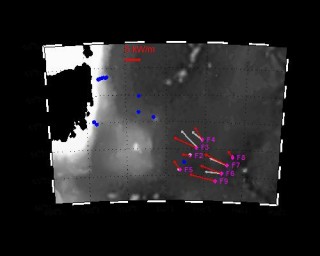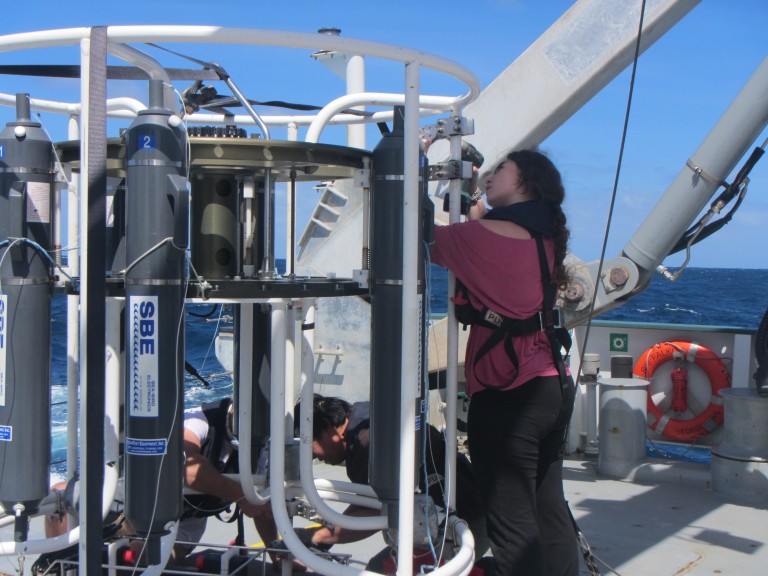After 26 days at sea, the T-Beam crew has sailed back into port along the Derwent River, and tied up on land. We never expected this work to be easy – battling with the constant barrage of storms headed directly from the southern ocean – the Tasman Sea did not disappoint. We did, however, have a successful cruise.

Preliminary estimates of the internal tide energy flux (arrows) as measured from the Falkor. Pink triangles (F2-F9) are the locations of our CTD stations, and the red/grey arrows show our initial estimates of the semi-diurnal internal tide energy flux headed towards the Tasman slope right towards the T-TIDE moorings (blue circles).Sam Kelly, Luc Rainville, & Amy Waterhouse
Our part of the T-TIDE experiment was tasked with identifying the internal tide beam as it races across the Tasman Sea, through a sea of eddies to understand what the beam looks like before it slams into the continental slope of Tasmania. After starting out with some coordinated operations with the Revelle at the beginning of our cruise, we headed east and set up camp in the middle of the Tasman Sea.
We conducted a set of nine 25-30 hour CTD profiling stations with two different lines spanning the internal tide beam. Our CTD was equipped two ADCPs to get vertical profiles of horizontal velocity as well as chi-pods which are able to measure temperature (and turbulence) at a very high rate. T-TIDE Principal Investigators have been working tirelessly over the months & years leading up to these cruises to determine, to the best of their ability, where the internal tide beam might be. This has involved using satellite altimetry data as well as mathematical models designed to simulate what the internal tide characteristics look like and guided us in picking our CTD stations. Although our work has only just begun, and we will spend the next months (and years!) untangling the data set that we have obtained, our initial findings suggest that we found the beam!
Although we will all be scattering our separate ways very soon, there is really not enough that can be said about the incredible science crew on our T-Beam cruise. This includes the hard work of Captain Heiko and his ship’s crew. Everyone worked long hours and endured some of the worst weather – yet everyone was always ready for more, determined to get as much science as we could while being a great, fun group of people!

Hayley Dosser, a PhD student at University of Washington Applied Physics Lab, interviewed the science party yesterday asking us simply ‘Why you study the ocean?’ After thinking for a few minutes, I realized that this is a very profound question. I study the ocean because I love it – I love the complex physical signals that lie beneath the ocean surface, and as scientists, I feel that we are responsible for doing our part in understanding how these signals will change or affect our changing climate. The internal tide in the Tasman Sea is a process that we need to understand in order to broaden our understanding and ability to predict the future ocean and climate, and with these small steps, such as the T-TIDE experiment, we are making that process.
Fair seas to the Revelle T-TIDE contingent who are still out there making measurements! We are looking forward to your updates.
